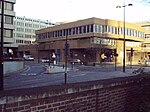Fatal Vespers
1623 disasters1623 in England17th century in LondonBuilding collapses in the United KingdomDisasters in London ... and 2 more
History of the City of LondonUse British English from December 2011

The Fatal Vespers was a 1623 structural collapse at Hunsdon House in Blackfriars, London, official residence of the French ambassador. There were 95 fatalities when the floor of an upper room collapsed under the weight of three hundred people who were attending a Roman Catholic service. Protestant polemicists interpreted the disaster as evidence of divine opposition to Papism.
Excerpt from the Wikipedia article Fatal Vespers (License: CC BY-SA 3.0, Authors, Images).Fatal Vespers
Queen Victoria Street, City of London
Geographical coordinates (GPS) Address Nearby Places Show on map
Geographical coordinates (GPS)
| Latitude | Longitude |
|---|---|
| N 51.5116 ° | E -0.103 ° |
Address
London Blackfriars Railway Station
Queen Victoria Street
EC4V 4DY City of London
England, United Kingdom
Open on Google Maps






